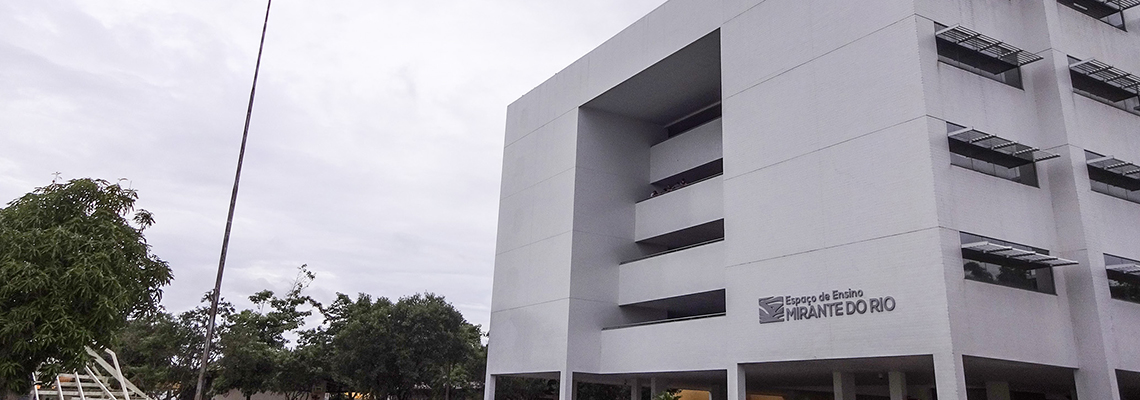Master’s/Doctorate
Area of Concentration: Animal Health
Molecular Biology (3 Credit Units, 60 Credit Hours)
Molecular constituents of cells. Structure of nucleic acids. Gene organization of prokaryotes and eukaryotes. DNA replication. Mutation and mechanisms of DNA repair. Genetic replication mechanism. Synthesis and RNA replication. Genetic code and protein synthesis. Compression of genetic material. Control of gene expression. Molecular biology techniques.
Medical Clinic in Company Animals (3 Credit Units, 45 Credit Hours)
The purpose of this subject is to discuss clinical cases based on the theoretical concepts described in the bibliographies, constructing a critical view of the techniques and procedures practiced in our reality.
Bacteriologic Diagnosis (3 Credit Units, 45 Credit Hours)
Introduction to bacteriology. Study of morphology and bacterial structure. Metabolism and genetics of prokaryotic organisms. Classification and preparation of culture media. Isolation and bacterial culture techniques. Bacterioscopy, staining and application of biochemical tests for bacterial classification.
Patologic Diagnosis (4 Credit Units, 60 Credit Hours)
Performing and describing routine necropsies; referral of material for inclusion in paraffin; histopathological diagnosis; interpretation of the macro and microscopic alterations and their association with the clinical signs and data of the complementary exams.
Diseases in the Central Nervous System of Ruminants and Equidae (3 Credit Units, 45 Credit Hours)
It studies the epidemiology, clinical signs, pathological changes, pathogenesis, diagnosis and differential diagnosis of the main diseases affecting the central nervous system (CNS) of Ruminants and Equidae.
Emergent and Re-emergent Diseases in Animals (3 Credit Units, 60 Credit Hours)
Conceptual Bases on Emerging and Reemerging Diseases; components and mechanisms; methods of prevention, control and eradication; Ebola virus; arboviruses of importance in animal health and public health; influenza virus; coronaviruses; malaria; mormo; epidemiological surveillance; methods of prevention, control and eradication.
Infectious Diseases of Ruminants (3 Credit Units, 60 Credit Hours)
Study of infectious-contagious and infectious diseases of Ruminants, pathogenesis, epizootiology, direct and indirect diagnostic methods of these agents at regional and national level, feasibility of the application of control and prophylaxis procedures and the focus of these agents aiming at their fight to protect Public Health .
Epidemiology and Control of the Monogastric Parasitoses (3 Credit Units, 60 Credit Hours)
To analyze the essential components of an ecosystem, considering the interactions between the agent, host and environment favoring or not favoring the parasitic health conditions or disease of the monogastric ones, observing the established dynamics in the transmission models of the agents of parasitic Diseases and investigation of the occurrence of parasitic diseases in populations.
Epidemiology and Control of the Ruminant Parasitoses (3 Credit Units, 60 Credit Hours)
To analyze the essential components of an ecosystem, considering the interactions between the agent, host and environment favoring or not favoring the parasitic health conditions or disease of the ruminants, observing the established dynamics in the transmission models of the agents of parasitic Diseases and investigation of the occurrence of parasitic diseases in populations.
Teaching Internship – Master’s (2 Credit Units, 30 Credit Hours)
The activity aims to guide the graduate student in the preparation of didactic material for theoretical and practical classes; to train the performance of the graduate student in theoretical and practical classes to the students of the normal course of graduation, in the specific disciplines of each advisor.
Teaching Internship II - Doctorate (4 Credit Units, 60 Credit Hours)
Didactic classes presentation of the different program subjects.
Physiology of Arthropods Vectors (3 Credit Units, 60 Credit Hours)
The subject will cover aspects of biology, internal anatomy and physiology of the major pathogen transmitting arthropods, with emphasis on those related to pathogen-vector interaction. Newly developed biochemical and molecular studies in the area will be tools for deepening the subject.
Fundamentals of the Epidemiological Investigationl (3 Credit Units, 60 Credit Hours)
The subject will address the main types of research regarding the occurrence of Diseases in populations. It will also provide the student with the conditions to plan, develop research projects and analyze results against different epidemiological procedures.
Immunology (3 Credit Units, 60 Credit Hours)
This subject aims to promote and deepen knowledge about aspects of the immune system, as well as the knowledge of techniques used for immunodiagnosis. The purpose of the subject is to intercalate the theoretical lectures with discussion of articles and seminars, thus addressing general and specific aspects related to the immunological system, as well as current discoveries of the same area.
Mecanisms of the Diseases in Animals (3 Credit Units, 45 Credit Hours)
The study of the Mechanisms of Diseases addresses the pathology and pathophysiology, integrating the study of the nature of the disease with the structural and functional changes that accompany the disease processes. Students will have access to knowledge about the structural and functional changes caused by the Diseases and what the results of these processes are. At the end of the subject, students will also gain greater skill in developing differential diagnoses related to Diseases. The subject is organized in order to address the general mechanisms of the Diseases, addressing in turn, the changes within the systems with their multiple causes. Various teaching methods will be used, including lectures, case discussions, based on laboratory sessions, necropsies, slide preparation and histopathology.
Toxic Plants and Intoxications in Ruminants and Equidae (3 Credit Units, 45 Credit Hours)
Provide the knowledge to diagnose the main poisonings in Ruminants and Equidae, caused by plants, mycotoxins, pesticides, heavy metals among others and their implications in public health. The study of the main toxic plants of the region and other toxic agents, its geographical distribution, its toxic principles and mechanisms of action, the factors that influence the toxicity of different toxic substances, clinical, epidemiology, pathology, control and treatment
Practices in Bacteriological Diagnosis (3 Credit Units, 45 Credit Hours)
Promote the study of the parasitic agents that affect the different Animals species, performing routine parasitological diagnosis techniques and advanced diagnostic techniques such as immunodiagnostic and biology and molecular techniques.
Health of Mammary Glands of Ruminants (3 Credit Units, 45 Credit Hours)
Provide students with the concepts and knowledge that allow to increase the quality of milk produced in the state of Pará, through the establishment of correct diagnosis and the use of effective mastitis control techniques, which may contribute to the reduction of the damages caused by the diseases of the mammary gland of Ruminants.
Seminar I (4 Credit Units, 60 Credit Hours)
It consists in approaching the scientific methodology and presentation, in the form of Seminar, of a research project for evaluation and discussion. The professors responsible for the subject and all students enrolled will participate in the discussion.
Seminar II (2 Credit Units, 30 Credit Hours)
It will contemplate the presentation, in the form of Seminar, of scientific articles related to the topic of dissertation
Seminars in Surgery Clinic of Small Animals (4 Credit Units, 60 Credit Hours)
Diagnosis of the problems of the surgical pathologies of the organic systems of small Animals. Interpretation of complementary tests (US, CCS, Milk composition and urea). Performing anesthetic procedures, both inhaled and injected. Performing routine surgical techniques, such as ovariohysterectomy, orchiectomy, skin and subcutaneous exeresis, mastectomy, and other procedures found during the discipline period. Seminars aimed at deepening the knowledge about the cases attended in the hospital.
Seminars in Medical Clinic of Small Animals (4 Credit Units, 60 Credit Hours)
Theoretical and practical approach of clinical cases of Companion Animals, attended in the routine of the Veterinary Hospital of Small Animals of the Federal University of Pará, including studies on etiology, pathophysiology, means of diagnosis, treatment and prophylaxis of Diseases.
Seminars in Histopatology of Domestic Animals (4 Credit Units, 60 Credit Hours)
Recognition of histopathological changes in Domestic Animals Diseases and association of these changes to macroscopic appearance and clinical signs and discussion of cases on the observation of illustrative histological preparations by presenter and participants.
Seminars in Histopatology of Domestic Animals II (4 Credit Units, 60 Credit Hours)
Recognition of histopathological changes in Domestic Animals Diseases and association of these changes to the macroscopic appearance and clinical signs and discussion of cases on the observation of illustrative histological preparations by presenter and participants
Techniques of Parasitological Diagnosis (3 Credit Units, 60 Credit Hours)
Promote the study of the parasitic agents that affect the different Animals species, performing routine parasitological diagnosis techniques and advanced diagnostic techniques such as immunodiagnostic and biology and molecular techniques.
Special Topics in Veterinary Anestesiology, Anestesial Monitoring and Anestesic Emergencies (2 Credit Units, 45 Credit Hours)
The subject Topics in Veterinary Anesthesiology, Anesthetic Monitoring and Anesthetic Emergencies aims to provide an in-depth knowledge of the general aspects of anesthetic drugs, as well as aspects related to the various forms of anesthetic monitoring in Veterinary Medicine. It also aims to study the conduct of emergency situations that may occur during anesthesia. The purpose of this subject is to present theoretical and practical lectures with discussion of articles, seminars and practical classes performed in the surgical center, thus addressing general and specific aspects of Anesthesiology as well as current discoveries in the same area.
Special Topics of Animal and Human Leptospirosis (3 Credit Units, 60 Credit Hours)
The subject of search provides opportunities and deepen knowledge about the general aspects of Leptospirosis, as well as specific aspects from an agent in Veterinary Medicine, in addition to providing the knowledge of serological diagnosis technique and culture technique from agent. The purpose of the subject is to promote discussions through scientific articles and in addition to effectively participate in the collection of material in the field for practical classes and serological diagnosis and to show the importance of leptospirosis in the animal and human species that have inter-species proximity leading to zoonosis.
Traumatology of Cats and Dogs (2 Credit Units, 30Credit Hours)
Comprises the clinical and surgical study of the Diseases that affect the nervous and locomotor system of dogs and cats with emphasis in traumatology.
Videosurgery and Videodiagnostic applied to Veterinary Medicine (4 Credit Units, 90 Credit Hours)
Enable the student to contact the resources of videosurgery and videodiagnosis applied as diagnostic, therapeutic and biotechnology in Veterinary Medicine, applied to company, production and wild animals.
Veterinary Virology (4 Credit Units, 75 Credit Hours)
The subject of Veterinary Virology aims to provide further knowledge about the general aspects of Virology, as well as specific aspects of the main viral agents in Veterinary Medicine, besides providing the search for knowledge of viral diagnostic techniques. The purpose of the course is to intercalate the theoretical lectures with discussion of articles and seminars, thus addressing general and specific aspects of virology as well as current discoveries of the same area.
Zoonosis of Company Animals (3 Credit Units, 45 Credit Hours)
The role of the veterinarian in the control of zoonoses that affect the Companion Animals. Classification of zoonoses addressing the etiology, epidemiology, pathogenesis, clinical presentation, diagnosis, treatment and prophylaxis, correlating with the socioeconomic aspects of Brazil.








